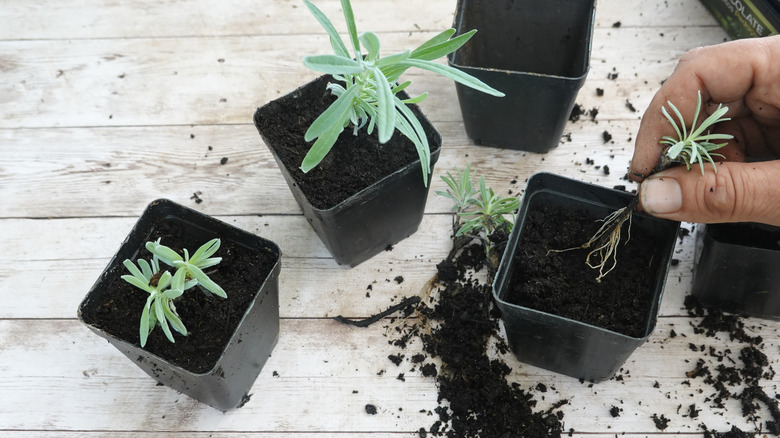Multiply Your Lavender Plants With One Easy Gardening Technique
Lavender (Lavandula) and its over 450 varieties are a stunning landscaping masterpiece. In addition to purple hues, there are some varieties that boast pink, white, yellow, or blue petals. It's not just stunning foliage and flowers that make this plant so enticing, either — the aroma, something you can find in many items from hand soap to candles, is vibrant, floral, and warm. Lavender is a hot spot for bees and butterflies; even human noses can't get enough of it. Since lavender is such a well-loved plant, it's in high demand. But there's an easy way to grow your collection without having to go to the nursery: propagation through cuttings.
The most common variety of this fragrant plant is English lavender (Lavandula angustifolia), which is cold-hardy in USDA Hardiness Zones 5 to 9. This is a highly recommended variety for cooler climates, and it's a versatile evergreen perennial shrub. Lavender in general likes hot, dry, and sandy or rocky soil in full sun since it's native to the Mediterranean coast. If you want to fill your garden with free lavender, propagating cuttings is easy, no matter what variety you have.
How to propagate your lavender
If you don't have any lavender plants of your own, you might know someone who does and can ask them to take a few cuttings. Start by making sure you have sharp cutting shears — it's not healthy for any plant to be ripped or crushed because your shears are dull. Find a stem that you can cut 4 to 6 inches off, and snip at a 45-degree angle just below a leaf joint (where the leaves connect to the stem). Remove the leaves on the bottom section of the stem and dip the end in rooting hormone for best results. Then, simply place the bare end of the cutting into a prepared pot of well-draining soil mix. You can use compost with perlite or grit.
Thoroughly water your lavender, then cover the whole pot with clear plastic wrap or a bottle to encourage root growth by maintaining higher humidity levels. Move your lavender to a warm, bright spot out of direct sunlight, and continue to water it so the soil remains moist but not soggy. The time of year you do this is important — summer is the best time to propagate your cuttings since the plant is actively growing and will root itself more easily.
Aftercare for your lavender cuttings
After about three to six weeks, your cutting should be forming roots and can lose the plastic covering completely. It's still too tender and needs more time before you move it outside, but once that time has come, find it a warm and sunny location in well-draining soil for it to flourish. There are some growing mistakes you need to avoid, such as overwatering this drought-resistant herb. But your lavender is well on its way to becoming a stunning, robust plant.
After your new plant is established, regular pruning after the cold of winter has dissipated and avoiding cutting the woody stems is essential to maintain its shape and growth. Encourage more lavender blooms by ensuring the soil continues to drain well, and in the colder months, protect your plant from the cold by covering the base with a winter mulch like straw or evergreen boughs, which will insulate your lavender and keep it healthy and thriving year after year.


